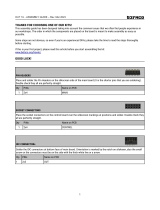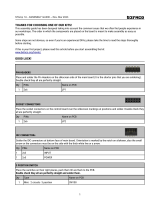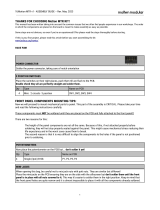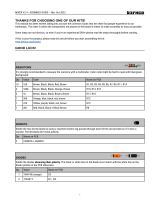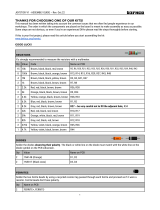Page is loading ...

CubuSynth Engine - Build Guide PCB V1.1 Jul 2022
Expander Module for the CubuSynth Engine
Build Guide
PCB V1.1 May 2022
Written and Illustrated by Ruben Sponar
Page 1

CubuSynth Engine - Build Guide PCB V1.1 Jul 2022
Introduction
This Build Guide is written for buiders with experience in soldering and assembling PCBs.
Due to the complexity of the build, the guide is focused on the steps that require special
care or techniques. Therefore, not every component value is described and listed as a
single step.
To help keeping track of the already placed components, print the BOM and cross out
the parts you already soldered.
Tools Required
- Soldering iron (+wire)
- side-cutter
- Nut wrench / driver M6, M8
Helpful, but not necessary:
- Digital Multimeter
- Helping (third) hand / PCB holder
Page 2

CubuSynth Engine - Build Guide PCB V1.1 Jul 2022
BUILD GUIDE
STEP 1 (Main PCB)
Diodes
Identify the 1N4148 diodes and put them in place. Orientation is Important! Make sure the line
on the diodes lines up with the stripe on the PCB silkscreen.
STEP 2 (Main PCB)
Resistors
There is different ways to go, you might already have developed your own method to place the
components and solder.
You can always select the resistors of the same value, place them, turn the board around and
solder in place. Trim the solder legs and move on to the next value.
Another method is to place all resistors and solder them from the top, without turning around
the board.
On the next page, you can find a picture of all resistors in place.
Page 3
2 1N4148 D8,D9
1 1k R135,R176,R221,R232
1 4k7 R138,R235
6 10k R137,R141,R143,R144,R153,R229,R230
2 20k R167,R231
7 100k
1 470k R136
R147,R154,R155,R177,R217,R218,R219,R220,
R222,R223,R224,R225,R226,R233

CubuSynth Engine - Build Guide PCB V1.1 Jul 2022
STEP 3 (Main PCB)
ceramic capacitors
1nf is marked as "102"
100nf is marked as "104"
Orientation doesn't matter. Put them in place and bend the solder legs outwards, so they don't
fall when turning around the board.
Solder all ceramic capacitors in place. On the next page you can see how your PCB should look
by now.
Page 4
3 1n C28,C29,C30
6 100n C12,C14,C16,C19,C25,C31

CubuSynth Engine - Build Guide PCB V1.1 Jul 2022
STEP 4 (Main PCB)
Power header
Turn around the board and place the Pin Header like shown below.
Put some tape, to hold them in place while soldering from the other side.
Page 5
1 HDR-M-2.54_2X5 H4

CubuSynth Engine - Build Guide PCB V1.1 Jul 2022
STEP 5 (Main PCB)
Transistor
Take the 2N3904, put it in place and make sure the orientation is correct. The outline of the
transistor has to match with the silkscreen on the PCB. You can bend the 2 outer legs of each
transistor, so it doesn't fall out when turning around the board.
The footprint is quite small, so stay focused and don't use too much solder to avoid shorts.
Check your solder joints with a magnifier and/or multimeter when in doubt.
STEP 6 (Main PCB)
IC sockets
Oriantation is important to know how to place the ICs later! The notch should face upwards,
matching the print on the PCB.
You can use tape to hold them in place, put the other PCB on top, or bend 2 pins of each socket
inwards, so they don't fall when turning the board around. Then solder everything.
Page 6
3 IC Socket 14Pin

CubuSynth Engine - Build Guide PCB V1.1 Jul 2022
STEP 7 (Main PCB)
Toggle Switch
Pin headers
Place the toggle switch in the correct spot.
Take the 8-Pin Headers (Male) and Sockets (Female) and stick them together. Place them on the
Main PCB, with the female header down, but don't solder yet!
Below you can see the correct placement of the switch and the pin headers.
Page 7

CubuSynth Engine - Build Guide PCB V1.1 Jul 2022
STEP 8
Control PCB
Now take the other PCB and fit it on top, so the shaft of the switch goes in the big hole and all
pins of the male headers are showing through their solder pads. Fit the nuts to the switch and
carefully turn the board around. Solder the Switch first, it will hold together the 2 PCBs while
soldering the pin headers on both sides (both PCBs).
STEP 9 (control PCB)
Resistors
After removing the nut from the switch and carefully taking apart the two PCBs, place and
solder the resistors on the control PCB as shown below.
Page 8
3 1k R135,R176,R221,R232
1 4k7 R138,R235
2 47k R227,R228
7 100k
R147,R154,R155,R177,R217,R218,R219,R220,
R222,R223,R224,R225,R226,R233

CubuSynth Engine - Build Guide PCB V1.1 Jul 2022
STEP 10 (Control PCB)
LED
For the LED the orientation is important! The longer leg goes in the upper hole, while the flat
side of the LED points down.
Solder it flush to the PCB.
STEP 17 (control PCB)
Controls
Now take the Potentiometers and jacks and put them in place as marked on the PCB but don't
solder yet.
On the next page you can see the placement
Page 9
1 LED-TH-3mm_W LED13
7 B100K AM,EXT,REF,SEL1,SEL2,SUB/2,SUB/4
5 PJ-301M J36,J37,J38,J39,J42

CubuSynth Engine - Build Guide PCB V1.1 Jul 2022
When everything is in place, put the front panel on top, so all controls go into each
corresponding hole of the panel. Make sure everything fits well.
Fit all nuts to the Potentiometers and Jacks.
Be careful when turning the boards around, so that the components stay in place.
Then solder everything.
Page 10

CubuSynth Engine - Build Guide PCB V1.1 Jul 2022
STEP 18
Installing ICs and final check
Now take the Main PCB and install the Ics. Make sure to install the chips in their specific spot.
Bend the Legs of the Ics inwards a bit so they form a 90° degree angle to the body of the chip.
Make sure the orientation is correct, the notch has to match the silkscreen / the sockets placed
before.
Check your soldering. If you see shorts or bad solder joints, fix it up. Then check the power pins
for shorts with your multimeter.
When everything looks fine, you can fit the control PCB, so the switch goes through its hole and
the Pin headers are connected properly. Then tighten the Nut for the switch on top.
Then You can fit the Front panel on top again. Fit all the nuts on the Potentiometers and Jacks.
Then place the knobs on the Potentiometers. For best results, turn all Potentiometers counter-
clockwise and push on the knobs, so the marking points towards the left end of the surrounding
circle.
To connect the module, plug in the 10pin Ribbon cable correctly to your CubuSynth Engine and
the Exhaust while your rack is powered OFF! Make sure orientation is correct. (Red stripe down).
Then turn on your case, and
Page 11

CubuSynth Engine - Build Guide PCB V1.1 Jul 2022
Please understand that we can't guarantee for your DIY module to work. Nevertheless we will do
our best to guide you through the build or to solve problems when needed.
In case there should be parts missing in your Full DIY kits contact us to ask for replacement /
If you have trouble with your build, you can contact us at the websites contact form or Mail:
To be able to identify mistakes in your build, please include quality pictures of your soldered
PCBs, front+back.
https://cubusynth.com/
https://www.facebook.com/cubusynth
https://www.instagram.com/cubusynth_modular/
https://www.tindie.com/stores/cubusynth/
https://www.etsy.com/shop/CubuSynth
Page 12
/

